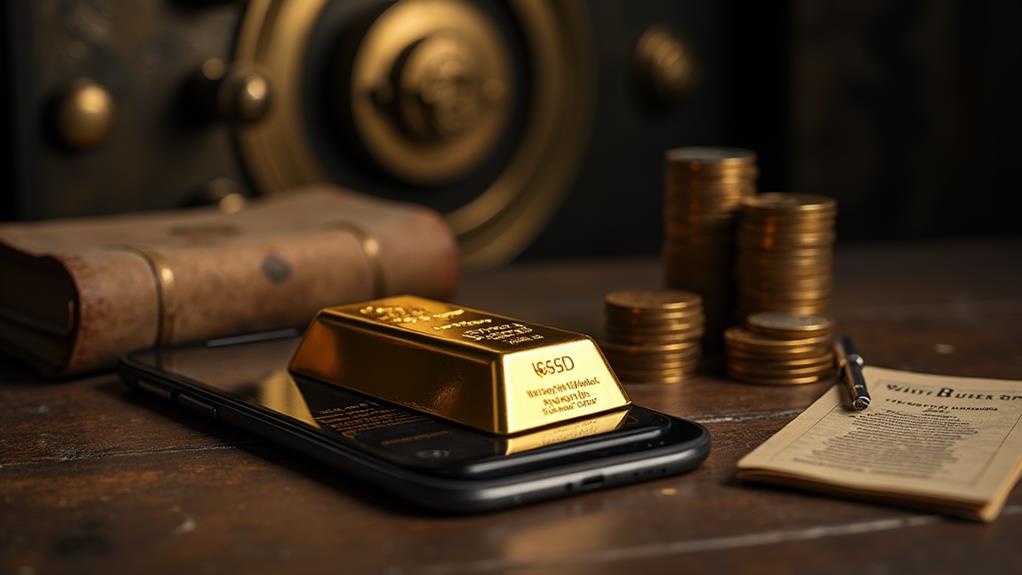Gold's voyage from ancient treasure to modern financial safeguard is a testament to its enduring allure. Throughout history, this precious metal has captivated civilizations, shaped economies, and weathered countless crises. Its transformation from primitive adornment to sophisticated investment vehicle reflects humanity's evolving relationship with wealth and value. As we investigate gold's remarkable trajectory, we'll uncover the crucial moments that cemented its status as a timeless asset. This inquiry not only illuminates our past but likewise offers valuable insights into the potential future of this glittering commodity in an ever-changing global economy.
Key Insights
- Gold's ancient roots as currency and store of value in civilizations like Egypt, Greece, and Rome established its enduring significance.
- The standardization of gold-based monetary systems and coinage facilitated trade and economic stability across centuries.
- Gold's consistent symbolism of wealth and power, coupled with its scarcity, enhanced its perceived value as a safe haven.
- The gold standard era promoted economic stability through fixed exchange rates, influencing modern investment strategies.
- Gold's performance during economic uncertainties, wars, and market volatility reinforced its role as a hedge against instability.
Ancient Roots of Gold's Value

For millennia, gold has held a unique position in human civilization as a symbol of wealth and power. The historical importance of gold investment can be traced back to ancient civilizations, where it served as both currency and a store of value.
Throughout history, gold has been mined, crafted into coins and bars, and treasured for its rarity and beauty. Ancient Egyptians, Greeks, and Romans all recognized the precious metal's worth, using gold in trade and as a measure of wealth.
The value of gold remained constant across cultures and time periods, cementing its status as a universal symbol of prosperity. As civilizations grew and trade expanded, gold became increasingly important in global commerce.
Its durability, divisibility, and scarcity made it an ideal medium of exchange, leading to the development of gold-based monetary systems that would persist for centuries.
Gold as Early Currency
Gold's role as an early currency revolutionized ancient trade, serving as a universally accepted medium of exchange across diverse cultures and regions.
As a symbol of wealth and power, gold coins became the preferred method for storing and transferring value, particularly for long-distance transactions.
The adoption of gold-based monetary systems by various civilizations helped standardize economic practices, laying the foundation for more complex financial structures in the centuries to come.
Ancient Trade Facilitator
When did gold first emerge as a medium of exchange? Gold has been used as a facilitator of trade since ancient times, long before the concept of a gold standard or gold bullion. Its intrinsic value and scarcity made it an ideal commodity for bartering and commerce across diverse cultures and regions.
As civilizations developed, gold became increasingly important in international trade, leading to the establishment of gold reserves and gold exchanges.
Ancient traders recognized gold's universal appeal, using it to:
- Facilitate long-distance trade routes
- Standardize value across different cultures
- Store wealth in a portable form
- Create intricate jewelry and ornaments
- Mint early forms of coinage
The role of gold in medieval Europe and during world wars further solidified its status as a timeless investment.
Even in the 20th century, gold remained a vital element in global economics, influencing monetary policies and investment strategies worldwide.
Symbol of Wealth
Throughout history, gold has consistently symbolized wealth and power across diverse civilizations. As a precious metal, gold is considered a safe haven for investors during economic uncertainties. Its enduring value has made gold the most popular choice for preserving wealth over generations.
Gold prices often rise when traditional currencies stumble, making it an attractive alternative investment. Gold has proven to be a reliable store of value, with many investors using gold to protect their assets against inflation and market volatility.
While gold is typically not used as everyday currency, its role as a symbol of wealth remains strong. The limited supply and fundamental beauty of gold contribute to its perceived value.
Nevertheless, investors should note that gold prices can be volatile in the short term, and diversification is essential to a balanced investment portfolio.
Standardizing Monetary Systems
The evolution of gold from a symbol of wealth to a standardized form of currency marked a significant shift in economic systems worldwide. As societies developed, the need for a universally accepted medium of exchange grew, leading to the establishment of gold-backed currencies.
Central banks began accumulating gold reserves to support their monetary systems, and the gold standard emerged as a means of standardizing monetary systems globally.
Key aspects of gold's role in standardizing monetary systems:
- Gold certificates issued as paper representations of gold holdings
- London Gold Fixing established to set daily gold prices
- Gold used as an inflation hedge during economic uncertainties
- Gold's impact on the Great Depression and subsequent economic policies
- World Gold Council formed to promote gold's monetary importance
Despite many countries abandoning the gold standard in the 20th century, gold's influence on monetary systems persists.
Its historical significance and perceived stability continue to shape economic policies and investment strategies globally.
Gold Standard Era

The gold standard era marked a significant shift in global economics, with many nations adopting a monetary system directly tied to gold.
Under this system, countries fixed their currency exchange rates to a specified amount of gold, creating a stable international framework for trade and finance.
While the gold standard initially provided economic stability and predictability, it likewise limited governments' ability to respond flexibly to economic crises, ultimately leading to its abandonment in the 20th century.
Global Monetary System Adoption
During the late 19th and early 20th centuries, gold's role in the global economy reached new heights with the widespread adoption of the gold standard. This system linked major currencies to a fixed amount of gold, creating stability in international trade and finance.
Nevertheless, it likewise exposed nations to potential gold market crashes and economic vulnerabilities.
The gold standard's impact on the global monetary system included:
- Increased demand for physical gold
- Standardization of gold coins and bars
- Greater emphasis on gold as a long-term investment
- Fluctuations in the price of gold affecting national economies
- Development of gold-backed financial instruments
As countries began to invest in gold reserves, it became an integral part of their investment portfolios.
This period solidified gold's position as a world-renowned store of value, influencing how individuals and nations would approach gold investment for generations to come.
Fixed Exchange Rates
Under the gold standard, fixed exchange rates took hold as a cornerstone of international monetary policy. This system pegged currencies to a specific gold rate, providing stability and predictability in international trade. The performance of gold as a store of value influenced investment decisions globally.
Key aspects of fixed exchange rates:
- Currencies were convertible to gold at a set price
- Gold demand increased as nations built reserves
- Spot prices remained relatively stable
- Gold futures markets emerged to manage risk
While the gold standard offered stability, it likewise presented challenges:
- Limited monetary policy flexibility
- Deflationary pressures during economic downturns
- Constraints on economic growth
Expert opinion:
"The gold standard provided a framework for long-term investment in gold, but it likewise restricted governments' ability to respond to economic crises," notes economist Dr. Sarah Thompson.
Economic Stability Impact
Proponents of the gold standard often lauded its ability to foster economic stability during its heyday. The system's fixed exchange rates and limited money supply were believed to provide:
- Predictable currency values
- Controlled inflation
- Stable international trade
- Reduced government debt
- Improved economic planning
However, the gold standard's impact on economic stability was not without controversy. While it may have helped mitigate market volatility in certain periods, critics argued that it could exacerbate economic downturns.
During a bear market, the demand for gold often increased, potentially leading to deflation and economic contraction.
Nonetheless, many investors continue to view gold as a hedge against economic uncertainty. A strategic allocation to gold can help diversify portfolios and potentially offset losses during market turbulence.
When contemplating gold investments, it's essential to align them with your specific investment objectives and risk tolerance.
World Wars and Gold
The global conflicts of the 20th century significantly impacted gold's role in the international monetary system. During World Wars I and II, many countries suspended the gold standard to finance their war efforts, leading to economic instability. Gold investors viewed the metal as a strategic allocation to hedge against uncertainty. As a good investment during turbulent times, individuals and nations sought to hold gold bullion coins and other forms of gold.
| Period | Gold Price (USD/oz) | Crucial Events |
|---|---|---|
| 1914-1918 | 20.67 | World War I |
| 1939-1945 | 35.00 | World War II |
| 1971 | 35.00 | Nixon Shock |
| 1980 | 850.00 | Gold reached all-time high |
The wars demonstrated that gold can provide stability when traditional currencies stumble. This realization became one of the primary reasons to invest in gold, as people tend to turn to gold during global crises.
Modern Gold Investment Strategies

Today's investors have a diverse array of options concerning gold investments. Modern strategies include purchasing gold ETFs, such as SPDR Gold Shares or iShares Gold Trust, which offer exposure to gold without physical ownership.
Digital gold platforms provide another avenue for investment, while traditional methods like buying physical gold or investing in gold mining companies remain popular. Gold funds offer a professionally managed approach to gold investment.
When reflecting on gold investments, investors should:
- Monitor the gold spot price regularly
- Diversify their portfolio with different gold-related assets
- Understand the risks associated with each investment type
- Seek professional investment advice
- Contemplate their long-term financial goals
It's essential to keep in mind that while gold can be a hedge against economic uncertainty, it doesn't generate income like stocks or bonds.
Investors should carefully evaluate their risk tolerance and financial objectives before allocating funds to gold investments.
Future Outlook for Gold
Experts predict three essential factors will shape gold's future in the coming decades: geopolitical tensions, technological advancements, and evolving economic policies.
While gold prices fell in recent years, the supply of gold remains limited, potentially leading to a surge in gold prices during uncertain times. The price of gold often fluctuates inversely with economic stability, making it a hedge against market volatility.
Many consider the return of gold as a good long-term investment, citing its historical performance and tangible value. Nevertheless, investing in the precious metal carries risks, as with any investment. Gold is likewise susceptible to market speculation and currency fluctuations.
The benefits of investing in gold include portfolio diversification and potential protection against inflation, but investors should carefully consider their financial goals and risk tolerance before committing to this asset.
My Final Thoughts
Gold's enduring allure as an investment transcends millennia, rooted in its inherent value and historical significance. From ancient civilizations to modern economies, gold has consistently served as a bastion of stability during financial turmoil. Its limited supply and universal appeal continue to drive demand, while technological advancements create new applications. As global economic uncertainties persist, gold's role as a safe-haven asset and hedge against inflation remains vital, solidifying its status as a timeless investment for generations to come.







